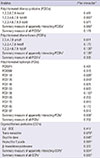1. U.S. Department of Health and Human Services. How tobacco smoke causes disease: the biology and behavioral basis for smoking-attributable disease: a report of the surgeon general. Atlanta: Department of Health and Human Services, Centers for Disease Control and Prevention, National Center for Chronic Disease Prevention and Health Promotion, Office on Smoking and Health;2010.
2. Jacobs DR Jr, Adachi H, Mulder I, Kromhout D, Menotti A, Nissinen A, Blackburn H. Cigarette smoking and mortality risk: twenty-five-year follow-up of the Seven Countries Study. Arch Intern Med. 1999; 159:733–740.
3. Doll R, Peto R, Wheatley K, Gray R, Sutherland I. Mortality in relation to smoking: 40 years' observations on male British doctors. BMJ. 1994; 309:901–911.
4. Hunt D, Blakely T, Woodward A, Wilson N. The smoking-mortality association varies over time and by ethnicity in New Zealand. Int J Epidemiol. 2005; 34:1020–1028.
5. Van de Mheen PJ, Gunning-Schepers LJ. Differences between studies in reported relative risks associated with smoking: an overview. Public Health Rep. 1996; 111:420–426.
6. Diwan BA, Ward JM, Kurata Y, Rice JM. Dissimilar frequency of hepatoblastomas and hepatic cystadenomas and adenocarcinomas arising in hepatocellular neoplasms of D2B6F1 mice initiated with N-nitrosodiethylamine and subsequently given Aroclor-1254, dichlorodiphenyltrichloroethane, or phenobarbital. Toxicol Pathol. 1994; 22:430–439.
7. Hutton JJ, Meier J, Hackney C. Comparison of the in vitro mutagenicity and metabolism of dimethylnitrosamine and benzo[a]pyrene in tissues from inbred mice treated with phenobarbital, 3-methylcholanthrene or polychlorinated biphenyls. Mutat Res. 1979; 66:75–94.
8. Ha MH, Lee DH, Jacobs DR. Association between serum concentrations of persistent organic pollutants and self-reported cardiovascular disease prevalence: results from the National Health and Nutrition Examination Survey, 1999-2002. Environ Health Perspect. 2007; 115:1204–1209.
9. Ha MH, Lee DH, Son HK, Park SK, Jacobs DR Jr. Association between serum concentrations of persistent organic pollutants and prevalence of newly diagnosed hypertension: results from the National Health and Nutrition Examination Survey 1999-2002. J Hum Hypertens. 2009; 23:274–286.
10. Lee DH, Lee IK, Porta M, Steffes M, Jacobs DR Jr. Relationship between serum concentrations of persistent organic pollutants and the prevalence of metabolic syndrome among non-diabetic adults: results from the National Health and Nutrition Examination Survey 1999-2002. Diabetologia. 2007; 50:1841–1851.
11. Lee DH, Lee IK, Song K, Steffes M, Toscano W, Baker BA, Jacobs DR Jr. A strong dose-response relation between serum concentrations of persistent organic pollutants and diabetes: results from the National Health and Examination Survey 1999-2002. Diabetes Care. 2006; 29:1638–1644.
12. Carpenter DO. Health effects of persistent organic pollutants: the challenge for the Pacific Basin and for the world. Rev Environ Health. 2011; 26:61–69.
13. Hong NS, Kim KS, Lee IK, Lind PM, Lind L, Jacobs DR, Lee DH. The association between obesity and mortality in the elderly differs by serum concentrations of persistent organic pollutants: a possible explanation for the obesity paradox. Int J Obes (Lond). 2012; 36:1170–1175.
14. Centers for Disease Control and Prevention (CDC). National Center for Health Statistics (NCHS): National Health and Nutrition Examination Survey Questionnaire (or Examination Protocol, or Laboratory Protocol). Hyattsville: U.S. Department of Health and Human Services, Centers for Disease Control and Prevention;accessed on 12 December 2012. Avaliable at
http://wwwn.cdc.gov/nchs/nhanes/search/nhanes03_04.aspx.
17. Korn EL, Graubard BI. Epidemiologic studies utilizing surveys: accounting for the sampling design. Am J Public Health. 1991; 81:1166–1173.
18. Graubard BI, Korn EL. Analyzing health surveys for cancer-related objectives. J Natl Cancer Inst. 1999; 91:1005–1016.
19. Lee DH, Steffes MW, Sjödin A, Jones RS, Needham LL, Jacobs DR Jr. Low dose organochlorine pesticides and polychlorinated biphenyls predict obesity, dyslipidemia, and insulin resistance among people free of diabetes. PLoS One. 2011; 6:e15977.
20. Lee DH, Steffes MW, Sjödin A, Jones RS, Needham LL, Jacobs DR Jr. Low dose of some persistent organic pollutants predicts type 2 diabetes: a nested case-control study. Environ Health Perspect. 2010; 118:1235–1242.
21. Kim KY, Kim DS, Lee SK, Lee IK, Kang JH, Chang YS, Jacobs DR, Steffes M, Lee DH. Association of low-dose exposure to persistent organic pollutants with global DNA hypomethylation in healthy Koreans. Environ Health Perspect. 2010; 118:370–374.
22. Fucic A, Gamulin M, Ferencic Z, Rokotov DS, Katic J, Bartonova A, Lovasic IB, Merlo DF. Lung cancer and environmental chemical exposure: a review of our current state of knowledge with reference to the role of hormones and hormone receptors as an increased risk factor for developing lung cancer in man. Toxicol Pathol. 2010; 38:849–855.
23. Psaty BM, Koepsell TD, Manolio TA, Longstreth WT Jr, Wagner EH, Wahl PW, Kronmal RA. Risk ratios and risk differences in estimating the effect of risk factors for cardiovascular disease in the elderly. J Clin Epidemiol. 1990; 43:961–970.
24. Shinton R, Beevers G. Meta-analysis of relation between cigarette smoking and stroke. BMJ. 1989; 298:789–794.
25. Lagueux J, Pereg D, Ayotte P, Dewailly E, Poirier GG. Cytochrome P450 CYP1A1 enzyme activity and DNA adducts in placenta of women environmentally exposed to organochlorines. Environ Res. 1999; 80:369–382.
26. Glynn AW, Granath F, Aune M, Atuma S, Darnerud PO, Bjerselius R, Vainio H, Weiderpass E. Organochlorines in Swedish women: determinants of serum concentrations. Environ Health Perspect. 2003; 111:349–355.
27. Deutch B, Pedersen HS, Jørgensen EC, Hansen JC. Smoking as a determinant of high organochlorine levels in Greenland. Arch Environ Health. 2003; 58:30–36.








 PDF
PDF ePub
ePub Citation
Citation Print
Print



 XML Download
XML Download